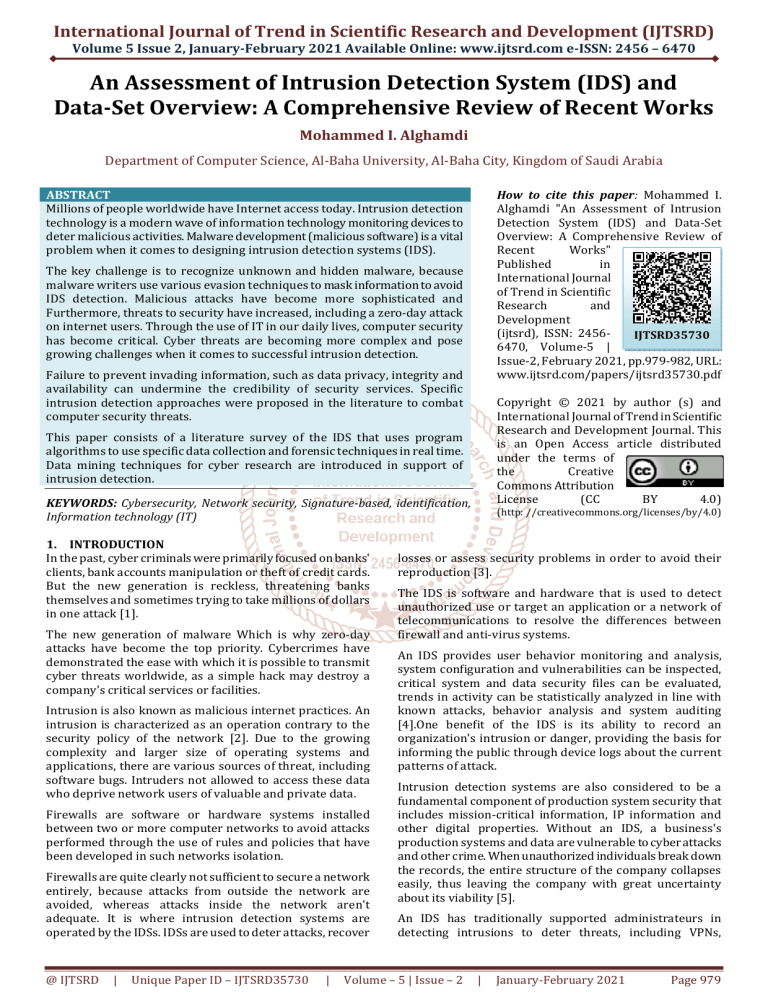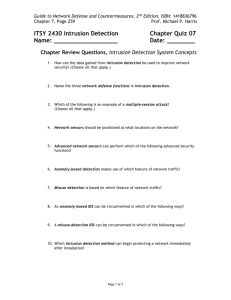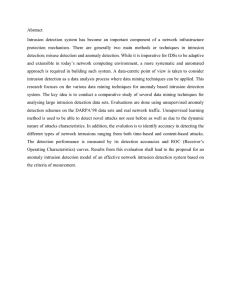
International Journal of Trend in Scientific Research and Development (IJTSRD)
Volume 5 Issue 2, January-February 2021 Available Online: www.ijtsrd.com e-ISSN: 2456 – 6470
An Assessment of Intrusion Detection System (IDS) and
Data-Set Overview: A Comprehensive Review of Recent Works
Mohammed I. Alghamdi
Department of Computer Science, Al-Baha University, Al-Baha City, Kingdom of Saudi Arabia
How to cite this paper: Mohammed I.
Alghamdi "An Assessment of Intrusion
Detection System (IDS) and Data-Set
Overview: A Comprehensive Review of
Recent
Works"
Published
in
International Journal
of Trend in Scientific
Research
and
Development
(ijtsrd), ISSN: 2456IJTSRD35730
6470, Volume-5 |
Issue-2, February 2021, pp.979-982, URL:
www.ijtsrd.com/papers/ijtsrd35730.pdf
ABSTRACT
Millions of people worldwide have Internet access today. Intrusion detection
technology is a modern wave of information technology monitoring devices to
deter malicious activities. Malware development (malicious software) is a vital
problem when it comes to designing intrusion detection systems (IDS).
The key challenge is to recognize unknown and hidden malware, because
malware writers use various evasion techniques to mask information to avoid
IDS detection. Malicious attacks have become more sophisticated and
Furthermore, threats to security have increased, including a zero-day attack
on internet users. Through the use of IT in our daily lives, computer security
has become critical. Cyber threats are becoming more complex and pose
growing challenges when it comes to successful intrusion detection.
Failure to prevent invading information, such as data privacy, integrity and
availability can undermine the credibility of security services. Specific
intrusion detection approaches were proposed in the literature to combat
computer security threats.
Copyright © 2021 by author (s) and
International Journal of Trend in Scientific
Research and Development Journal. This
is an Open Access article distributed
under the terms of
the
Creative
Commons Attribution
License
(CC
BY
4.0)
This paper consists of a literature survey of the IDS that uses program
algorithms to use specific data collection and forensic techniques in real time.
Data mining techniques for cyber research are introduced in support of
intrusion detection.
KEYWORDS: Cybersecurity, Network security, Signature-based, identification,
Information technology (IT)
1. INTRODUCTION
In the past, cyber criminals were primarily focused on banks'
clients, bank accounts manipulation or theft of credit cards.
But the new generation is reckless, threatening banks
themselves and sometimes trying to take millions of dollars
in one attack [1].
The new generation of malware Which is why zero-day
attacks have become the top priority. Cybercrimes have
demonstrated the ease with which it is possible to transmit
cyber threats worldwide, as a simple hack may destroy a
company's critical services or facilities.
Intrusion is also known as malicious internet practices. An
intrusion is characterized as an operation contrary to the
security policy of the network [2]. Due to the growing
complexity and larger size of operating systems and
applications, there are various sources of threat, including
software bugs. Intruders not allowed to access these data
who deprive network users of valuable and private data.
Firewalls are software or hardware systems installed
between two or more computer networks to avoid attacks
performed through the use of rules and policies that have
been developed in such networks isolation.
Firewalls are quite clearly not sufficient to secure a network
entirely, because attacks from outside the network are
avoided, whereas attacks inside the network aren't
adequate. It is where intrusion detection systems are
operated by the IDSs. IDSs are used to deter attacks, recover
@ IJTSRD
|
Unique Paper ID – IJTSRD35730
|
(http: //creativecommons.org/licenses/by/4.0)
losses or assess security problems in order to avoid their
reproduction [3].
The IDS is software and hardware that is used to detect
unauthorized use or target an application or a network of
telecommunications to resolve the differences between
firewall and anti-virus systems.
An IDS provides user behavior monitoring and analysis,
system configuration and vulnerabilities can be inspected,
critical system and data security files can be evaluated,
trends in activity can be statistically analyzed in line with
known attacks, behavior analysis and system auditing
[4].One benefit of the IDS is its ability to record an
organization's intrusion or danger, providing the basis for
informing the public through device logs about the current
patterns of attack.
Intrusion detection systems are also considered to be a
fundamental component of production system security that
includes mission-critical information, IP information and
other digital properties. Without an IDS, a business's
production systems and data are vulnerable to cyber attacks
and other crime. When unauthorized individuals break down
the records, the entire structure of the company collapses
easily, thus leaving the company with great uncertainty
about its viability [5].
An IDS has traditionally supported administrateurs in
detecting intrusions to deter threats, including VPNs,
Volume – 5 | Issue – 2
|
January-February 2021
Page 979
International Journal of Trend in Scientific Research and Development (IJTSRD) @ www.ijtsrd.com eISSN: 2456-6470
malware security, firewalls or controlled IT, as part of a
robust safety strategy. But the position of IDS is rising
slowly. Hackers ' innovations for hiking a network and
administrators ' countertechnology in order to deal with
these attacks have outperformed the scope and ability of IDS.
It has been all but old-fashioned for an IDS to track threats in
real time and zero day[6].
Intrusion detection systems (IDS) are among the latest
security tools. Based on their characteristics, I can classify
them into different types, such as their detection and
prevention strategies, their architecture, or the detection
range[7]. In fact, given their effectiveness, most IDS have two
problems: the large number of false positives and negatives.
The false positives, the false alarms, are produced when the
IDS detects normal activities as intrusions, while the false
negatives correspond to non-detected attacks or intrusions,
and no warning is generated[8].
Three types of IDS-detected computer attacks exist:
(i) attacks by a scan device, (ii) attacks by a denial of service
and (iii) intrusion attacks[3]. Each of the three types of
computer attacks has distinct signatures and behavior-IDS is
scheduled for alarm evaluation, detection and detection.
2. Literature Review
In the literature, there are several techniques available to
detect the intrusion behavior. It is also very important to
maintain a high degree of protection and ensure that
communication between different organizations is secure
and trustworthy. Nonetheless, safe Internet and other
networks are still at risk of attack and misuse. Therefore,
intrusion detection systems have become a computer and
network protection feature that is essential. Different
methods in intrusion detections are used, but none of the
systems is still fully unreliable so far [9]. Intrusion detection
has been receiving a lot of attention among researchers in
recent times as it is commonly used to maintain protection
within a network. Here I present some of the intrusion
detection methods used.The fundamental task of the
detection system for intrusion is to identify network
behaviors as normal or abnormal while reducing
misclassification [10-12].
As stated by Owens and Levary, intruders' detection systems
have generally been established with the aid of expert
system technology. But in building systems, which are
difficult to deal with, lacking clear user interfaces and
unpleasant to use in real-world conditions, experts from the
Intrusion Detection Network (IDS) have been biased [13].
Numerous research papers on IDSs for technologies such as
mobile ad hoc networks (MANETs) [14-16], wireless sensor
networks (WSNs) [17-19], and cloud computing [20] and
cyber-physical systems (CPS) [21] have been published over
the past few years. Zarpelao et al. [22] provide an IDS
analysis.
They discuss IDS placement strategies and detection
methods in their survey article. I also pose common security
threats and how to identify those using IDSs. In addition,
they present a review of the common validation strategies
used in intrusion detection methods and discuss open
research issues and trends in the future.
In signature-based approaches, IDS detect attacks when the
device / network activity matches an IDS attack symbol. If
any device or network behavior is consistent with the stored
patterns / signatures, an alert is activated. This approach is
@ IJTSRD
|
Unique Paper ID – IJTSRD35730
|
very effective and efficient in the identification of known
threats and is easily understood by its process. Nonetheless,
in detecting new attacks and variants of known attacks this
strategy is failing, as a corresponding signature for such
attacks is still unknown[23-24].
The following advantages are provided by signature
detection methods: low false alarm rate, simple algorithms,
and easy database creation for attack signatures, quick
implementation and usually minimum computer resource
use.
Several drawbacks:
Problems in adding different forms of attack details
(when adding the attack signature database, as
appropriate).
New threats that are unknown cannot automatically be
identified. The Attack Signature database must be
continuously updated.
Maintaining IDS is necessarily linked to the detection
and patching of safety holes that are time consuming.
[23-24].
IDSs based on anomalies compare system behaviors at a
time with a normal behavioral profile and alarm when an
abnormality crosses a threshold. Nonetheless, something
that does not match a normal behavior is considered an
violation, and it is not a easy task to grasp the whole
spectrum of normal conduct. Generally the false positive
rates of this process are high [22, 25]. Researchers usually
construct the standard behavior profile with statistical
techniques or machine learning algorithms.
Arman Tajbakhsh suggested an IDS-based system for data
mining techniques. In the Association Based Classification
(ABC) system, the classification engine is, in turn, the core
part of the IDS [26].
The classification proposed using fuzzy association rules to
create classifiers. Such tests were used to assess the validity
of every new sample (which must be categorized) and to
establish the sample mark as the best corresponding class
rule collection. A procedure that reduces items that can be
included in the rules extracted is also proposed to reduce the
time the rule induction algorithm takes. The layout has been
checked with the KDD-99 dataset. The findings indicate that
the overall detection rate of known attacks was high and the
false positive rate was low, even though the results of the
unknown attacks were not obvious. [26].
3. Methodology
I reviewed 20 works published in the last 16 years between
2002 and 2018 proposing IDS solutions in this study. I used a
taxonomy focused on features such as the placement
technique, the method of detection and the threat of security.
4. Results and Discussion
Most published documents claiming to evaluate IDSs are
performed as comparisons rather than assessments.
Assessment should be viewed as assessing the extent at
which a given IDS achieves defined performance targets.
There are many problems in IDS and need to be solved, such
as poor detection capacity against unknown network attack,
high false alarm rate, and inadequate analytical capability
[10-12].
IDS systems distinguish between requirements. In the first
place, IDSs can be distinguished on the basis of the type of
operations, traffic, transactions or structures they control.
Volume – 5 | Issue – 2
|
January-February 2021
Page 980
International Journal of Trend in Scientific Research and Development (IJTSRD) @ www.ijtsrd.com eISSN: 2456-6470
IDSs can be divided into network, host and application-based
groups of IDS. Network-based IDS are known as networkbased IDSs that monitor Network backbones and check for
intrusion signatures, while those on hosts identify, track and
host host-based IDSs.
Many IDSs only monitor applications directly and are
classified as application-based IDSs. (Such care is usually
restricted to broad applications like database systems,
content management systems, accounts, etc.)[27].
Different approaches of IDS control:
4.1. Network-based IDS Characteristics:
Network IDSs are capable of controlling and overloading a
large network with only few well-placed nodes or
computers. Network-based IDSs are mainly passive tools to
control the ongoing activity of the network without
excessive interference. It is easy to defend against attack and
can also not be detected by attackers; it also takes little effort
to mount and use existing networks. Network-based IDS
does not monitor and analyze all traffic on large, busy
networks and therefore neglect attacks during peak traffic.
Organizations incorporate Intrusion Detection Systems (IDS)
to detect unauthorized behaviors in the network or on
individual machines. Detection of intrusion has been studied
for nearly 20 years. Intrusion Detection Systems track
malicious/unauthorized network activities, record
information on such activities / send alerts, take steps to
stop them / drop packets.
References
[1] Ablon L, Libicki MC, Golay AA. Markets for cybercrime
tools and stolen data: Hackers' bazaar. Rand
Corporation; 2014.
[2]
Awan JH, Memon S, Khan RA, Noonari AQ, Hussain Z,
Usman M. Security strategies to overcome cyber
measures, factors and barriers. Eng. Sci. Technol. Int.
Res. J. 2017; 1(1):51-8.
[3]
Anderson JP. Computer security threat monitoring
and surveillance. Technical Report, James P. Anderson
Company. 1980.
[4]
Chen Q, Abdelwahed S, Erradi A. A model-based
validated autonomic approach to self-protect
computing systems. IEEE Internet of things Journal.
2014; 1(5):446-60.
[5]
Ashoor AS, Gore S. Importance of intrusion detection
system (IDS). International Journal of Scientific and
ngineering Research. 2011; 2(1):1-4.
4.2. Host-based IDS Characteristics:
IDS can analyze the host activities in a high degree of detail;
it can periodically analyze the processes and/or users
engaged in malicious activities. Whereas they are each
capable of focusing on a single host, most domain-based IDS
systems have an agent console model where agents work on
(and monitor) individual hosting systems and report to a
single centralized server (so that a multi-host console can set
up, track and aggregate data). Host-based IDSs can detect
undetectable attacks on network-based IDS and accurately
calculate the outcome of attacks. Host-based IDSs use hostbased encryption services to explore encrypted transport,
data, storage and operation.
[6]
Jabez J, Muthukumar B. Intrusion detection system
(IDS): anomaly detection using outlier detection
approach. Procedia Computer Science. 2015; 48:33846.
[7]
Debar, H., and Jouni V. "Intrusion detection:
Introduction to intrusion detection and security
information management." Foundations of security
analysis and design III. Springer, Berlin, Heidelberg,
2005. 207-236.
[8]
Debar, H., Marc D., and Andreas W. "IN Revised
Taxonomy Heart Intrusion Detection Systems."
Annals of the Telecommunications, Flight 55: 7-8.
Data collection is per host; writing to logs or recording
activities requires network traffic and can reduce network
performance. Clever server-based attackers can also target
and disable host-based IDSs. DoS attacks can thwart server
based IDSs (because they can prevent traffic from reaching
host where it is running or because they may prevent
reporting on such attacks to a console otherwise in a
network). In particular, a host-based IDS uses the server that
runs these Systems for process time, energy, memory and
other resources
[9]
Kadam PU, Deshmukh M. Various approaches for
intrusion detection system: an overview.
International Journal of Innovative Research in
Computer and Communication Engineering. 2014
Nov; 2(11).
[10]
Wilkison M. IDFAQ: how to evaluate network
intrusion detection systems. Retrieved from SANS
Technology Institute: https://www.sans.org/securityresources/idfaq/how-toevaluate-network-intrusiondetection-systems/8/10. 2002.
[11]
Mohammadpour L, Hussain M, Aryanfar A, Raee VM,
Sattar F. Evaluating performance of intrusion
detection system using support vector machines.
International Journal of Security and Its Applications.
2015 Sep; 9(9):225-34.
[12]
Kuang F, Xu W, Zhang S. A novel hybrid KPCA and
SVM with GA model for intrusion detection. Applied
Soft Computing. 2014 May 1; 18:178-84.
[13]
Peiravi A. Application of string matching in Internet
Security and Reliability. Marsland Press Journal of
American Science. 2010; 6(1):25-33.
In addition, network-based IDSs cannot track switch-based
(high-speed) networks effectively. Network based IDSs are
usually unable to analyze encrypted data or disclose attack
success or failure. Therefore, network IDSs require the
involvement of manual network managers to assess the
impact of reported attacks to a certain extent [28-29].
5. Conclusion
Cyber threats are becoming more complex and pose growing
challenges when it comes to successful intrusion detection.
Failure to prevent invading information, such as data
privacy, integrity and availability can undermine the
credibility of security services.
In order to protect data during transmission, network
security measures were required. Safety of the network
includes securing a network from unauthorized access and
risks. Network administrators / Information Security
experts have a duty to take proactive measures to protect
their networks from potential threats to security.
@ IJTSRD
|
Unique Paper ID – IJTSRD35730
|
Volume – 5 | Issue – 2
|
January-February 2021
Page 981
International Journal of Trend in Scientific Research and Development (IJTSRD) @ www.ijtsrd.com eISSN: 2456-6470
[14]
Mishra A, Nadkarni K, Patcha A. Intrusion detection in
wireless ad hoc networks. IEEE wireless
communications. 2004; 11(1):48-60.
[15]
Anantvalee T, Wu J. A survey on intrusion detection in
mobile ad hoc networks. InWireless Network
Security. Springer, Boston, MA. 2007 (pp. 159-180).
[16]
Kumar S, Dutta K. Intrusion detection in mobile ad
hoc networks: techniques, systems, and future
challenges. Security and Communication Networks.
2016 Sep 25; 9(14):2484-556.
Computing Surveys (CSUR). 2014 Apr 1; 46(4):55.
[22]
Zarpelão BB, Miani RS, Kawakani CT, de Alvarenga SC.
A survey of intrusion detection in Internet of Things.
Journal of Network and Computer Applications. 2017;
84:25-37.
[23]
Vacca, J. Computer and Information Security
Handbook. Morgan Kaufmann, Amsterdam, 2013.
[24]
Liao HJ, Lin CH, Lin YC, Tung KY. Intrusion detection
system: A comprehensive review. Journal of Network
and Computer Applications. 2013; 36(1):16-24.
[25]
Scarfone, K. and Mell, P. “Guide to intrusion detection
and prevention systems (IDPS)”, Technical report,
National Institute of Standards and Technology,
Special Publication, 2007; 80-94.
[17]
Farooqi AH, Khan FA. Intrusion detection systems for
wireless sensor networks: A survey. In International
Conference on Future Generation Communication and
Networking. Springer, Berlin, Heidelberg. 2009; pp.
234-241.
[18]
Abduvaliyev A, Pathan AS, Zhou J, Roman R, Wong
WC. On the vital areas of intrusion detection systems
in wireless sensor networks. IEEE Communications
Surveys & Tutorials. 2013; 15(3):1223-37.
[26]
Tajbakhsh A, Rahmati M, Mirzaei A. Intrusion
detection using fuzzy association rules. Applied Soft
Computing. 2009; 9(2):462-9.
[27]
Butun I, Morgera SD, Sankar R. A survey of intrusion
detection systems in wireless sensor networks. IEEE
communications surveys & tutorials. 2013;
16(1):266-82.
Jyothsna VV, Prasad VR, Prasad KM. A review of
anomaly based intrusion detection systems.
International Journal of Computer Applications. 2011
Aug; 28(7):26-35.
[28]
Modi C, Patel D, Borisaniya B, Patel H, Patel A,
Rajarajan M. A survey of intrusion detection
techniques in cloud. Journal of network and computer
applications. 2013; 36(1):42-57.
Kreibich C, Handley M, Paxson V. Network intrusion
detection: Evasion, traffic normalization, and end-toend protocol semantics. InProc. USENIX Security
Symposium 2001 (Vol. 2001).
[29]
Ashour A. importance of Intrusion Detection System
(IDS). International Journal of Scientific Engineering
Research, 2005; 1-7.
[19]
[20]
[21]
Mitchell R, Chen IR. A survey of intrusion detection
techniques for cyber-physical systems. ACM
@ IJTSRD
|
Unique Paper ID – IJTSRD35730
|
Volume – 5 | Issue – 2
|
January-February 2021
Page 982




